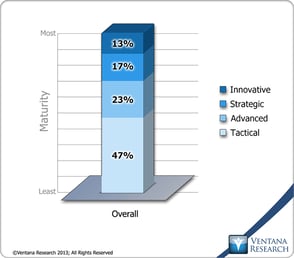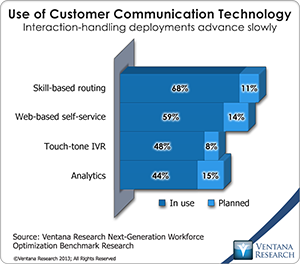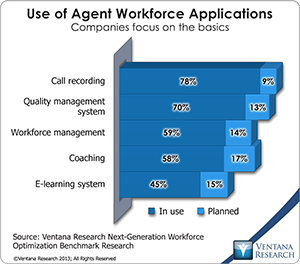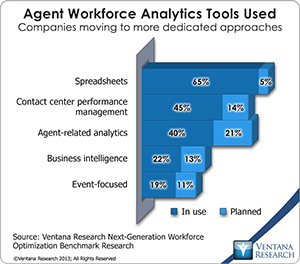Ventana Research defines workforce optimization as a set of processes and technology for customer agents that include interaction (call) recording, quality monitoring, workforce management,  training and coaching, compensation management and analytics. My benchmark research into next-generation workforce optimization set out to discover the people, processes, information and systems companies are using to get more from their customer service agents, the benefits they have gained, their plans to change and the barriers holding back those changes. Our research projects apply the Ventana Research Maturity Model™ to evaluate the maturity of organizations in a given market or with respect to a business or IT process. In this case our analysis shows that based on current practices nearly half of companies are at the lowest Tactical level of maturity and only 13 percent have reached the highest Innovative level. Closer examination of the results shows that companies are least mature in their use of technology for workforce optimization, with half at the Tactical level. Much has changed in the way companies handle customer interactions. Two of the biggest changes I have seen in various research are that companies now support more channels of communication and more employees around the organization are involved in handling interactions, meaning companies need to review their workforce optimization systems and begin to take advantage of these advances. Yet the research shows that most of them aren’t yet doing that.
training and coaching, compensation management and analytics. My benchmark research into next-generation workforce optimization set out to discover the people, processes, information and systems companies are using to get more from their customer service agents, the benefits they have gained, their plans to change and the barriers holding back those changes. Our research projects apply the Ventana Research Maturity Model™ to evaluate the maturity of organizations in a given market or with respect to a business or IT process. In this case our analysis shows that based on current practices nearly half of companies are at the lowest Tactical level of maturity and only 13 percent have reached the highest Innovative level. Closer examination of the results shows that companies are least mature in their use of technology for workforce optimization, with half at the Tactical level. Much has changed in the way companies handle customer interactions. Two of the biggest changes I have seen in various research are that companies now support more channels of communication and more employees around the organization are involved in handling interactions, meaning companies need to review their workforce optimization systems and begin to take advantage of these advances. Yet the research shows that most of them aren’t yet doing that.
Handling interactions requires three types of systems: systems to manage inbound and outbound communications, business applications to manage the people side of business transactions, and analytics to monitor and assess performance. My research shows that most companies use basic communication systems: skills-based routing (68%), Web-based self-service (59%) and touch-tone IVR (48%). This indicates that companies are more focused on persuading customers to use self-service rather than on enabling them to interact directly with a contact center agent or other employee. In terms of analytics, use of such tools has increased but mostly in basic ways, focusing on analyzing call patterns and agent performance using
to manage inbound and outbound communications, business applications to manage the people side of business transactions, and analytics to monitor and assess performance. My research shows that most companies use basic communication systems: skills-based routing (68%), Web-based self-service (59%) and touch-tone IVR (48%). This indicates that companies are more focused on persuading customers to use self-service rather than on enabling them to interact directly with a contact center agent or other employee. In terms of analytics, use of such tools has increased but mostly in basic ways, focusing on analyzing call patterns and agent performance using  spreadsheets or other standard business intelligence and analytics tools. A more encouraging sign is that the use of analytics is predicted to be one of the highest growth areas, increasing 15 percent over the next 12 months, slightly less than unified communications (17%) and equal to Web-based instant messaging. The adoption of unified communications will help employees across an organization collaborate on interactions, while Web-based IM supports customers who prefer this channel. By adopting such systems companies should realize benefits over and above those gained so far, which include improved customer service, increased customer satisfaction and decreased volumes of inbound calls. Companies that provide communication management systems have responded to changing consumer communication preferences. As such, now is the time companies should adopt these systems or otherwise risk losing market share.
spreadsheets or other standard business intelligence and analytics tools. A more encouraging sign is that the use of analytics is predicted to be one of the highest growth areas, increasing 15 percent over the next 12 months, slightly less than unified communications (17%) and equal to Web-based instant messaging. The adoption of unified communications will help employees across an organization collaborate on interactions, while Web-based IM supports customers who prefer this channel. By adopting such systems companies should realize benefits over and above those gained so far, which include improved customer service, increased customer satisfaction and decreased volumes of inbound calls. Companies that provide communication management systems have responded to changing consumer communication preferences. As such, now is the time companies should adopt these systems or otherwise risk losing market share.
My research into use of agent desktop systems shows that companies understand that agents have a profound impact on the customer experience, and as companies involve more back-office employees in handling interactions, the importance of managing this vital resource increases. However, the research shows that, as in the case of communication technologies, the majority of companies are still using basic workforce optimization systems, focusing on call recording and quality management. Most have not started capturing nonvoice interactions or adopted compensation management systems to help manage variable pay for agents, such as commissions paid for results. Indicating recognition of the role agents play in the customer experience, the most popular planned systems are coaching and e-learning, to better focus both to agents’ specific needs. The biggest change from previous benchmark research results is the level of planned adoption of collaboration systems (by 16% in the next year), which I attribute to the increasing importance of first-contact resolution and thus the need to give agents easier methods to find and collaborate with experts to resolve issues. We also find that investments pay off: Companies that have adopted next-generation workforce optimization systems have seen an average of six benefits, the top three being improved coaching (66%), improved customer satisfaction (52%) and better agent quality scores (51%).
Meanwhile, a closer look at the use of analytics shows that  although adoption is widely planned, it hasn’t actually happened much. The most popular analytics tool by far remains spreadsheets, and although these are cheap and relatively easy to use, they require a lot of manual effort (often to correct errors) and don’t yield insights from the volumes of unstructured data being generated in the new forms of interactions with customers. For example, our research shows that analytics for social media (13%), speech (13%) and text (9%) are still at the early adopter stage. The planned growth areas reflect the increasing importance of understanding agent performance (21%) and the increasing need to understand the customer journey across channels: Multichannel analytics are the second most often planned tool (15%). The planned adoption of other forms of analytics all fall within 10 to 14 percent, with the notable exception of spreadsheets, which are least likely to be adopted (5%). The lack of more advanced systems is reflected in the benefits companies have seen in adopting analytics; the top two are that the analysis includes more up-to-date data and are available faster (both 49%). While these are important, as companies come to recognize the need to understand the outcomes of interactions, I expect more to seek the benefit of more outcome-based metrics.
although adoption is widely planned, it hasn’t actually happened much. The most popular analytics tool by far remains spreadsheets, and although these are cheap and relatively easy to use, they require a lot of manual effort (often to correct errors) and don’t yield insights from the volumes of unstructured data being generated in the new forms of interactions with customers. For example, our research shows that analytics for social media (13%), speech (13%) and text (9%) are still at the early adopter stage. The planned growth areas reflect the increasing importance of understanding agent performance (21%) and the increasing need to understand the customer journey across channels: Multichannel analytics are the second most often planned tool (15%). The planned adoption of other forms of analytics all fall within 10 to 14 percent, with the notable exception of spreadsheets, which are least likely to be adopted (5%). The lack of more advanced systems is reflected in the benefits companies have seen in adopting analytics; the top two are that the analysis includes more up-to-date data and are available faster (both 49%). While these are important, as companies come to recognize the need to understand the outcomes of interactions, I expect more to seek the benefit of more outcome-based metrics.
Research results highlight two other important trends in the adoption of other systems. First, companies are increasingly recognizing the importance of workforce optimization systems being better integrated, both with one another and with other systems, such as communication technologies and other business applications. As I noted, workforce optimization consists of several applications, and closer integration will make them easier to set up and administer, reduce effort in copying data across systems and above all enable companies to connect business processes to create a more efficient and effective operation. Second, 37 percent of companies indicated that it is important to have access to their workforce optimization systems through mobile devices. This reflects the growing trend of employees working away from the office, accessing information while on the move and initiating actions such as changing the profiles of teams of agents to shorten inbound queue lengths.
I also find a lack of maturity in using workforce optimization systems in two points I raised in another perspective I wrote about the result of this research: Companies are not planning action that will deliver their desired business goals, and the metrics they use also don’t reflect these goals. There is still a focus on efficiency, which, while important, doesn’t necessarily help improve customer satisfaction and the customer experience. People still play an important role in handling interactions, and if companies want to get more customer-focused, now is the time for change. Mature companies are adopting next-generation workforce optimization systems to monitor and manage interaction management, and I expect more to follow suit and if they do not will see the impact through customer churn from customer dissatisfaction. So stay tuned during 2014, as I will be keeping track of how the market matures and the benefits that result.
Regards,
Richard J. Snow
VP & Research Director – Customer Engagement













